GLASS MENAGERIE
Design Process Notes
Theater at Monmouth
director: Bill Van Horn
sets: Daniel Bilodeau lights: Lynne Chase
costumes: Jonna Klaiber sound: Rew Tippin
Candles Without Flames in a Warehouse of the Mind
The Warehouse idea
Originally, the action was to be set in a warehouse. Tom would enter this warehouse, and set up the action by arranging items he found there to form a makeshift apartment. This might even include using wooden crates as furniture. The other characters would enter as he created the story in his imagination.
As Dan developed the set, I began thinking about light, using his early set drawings as a jumping off point. I sketched an idea about a window template washing the brick back wall of the set.

This drawing is based on early set drawings. Some aspects of this set were modified. The furniture shown was the closest that I could easily find to plug in to the file and does not exactly match what the set designer had in mind.
I fell in love with this look. I was admiring Dan's set in general. Then, for financial reasons, it was announced that the leadership was considering cutting that upstage wall. Gulp! (This reaction from both Dan and me.)
Eventually, the wall remained, but it was made smaller.
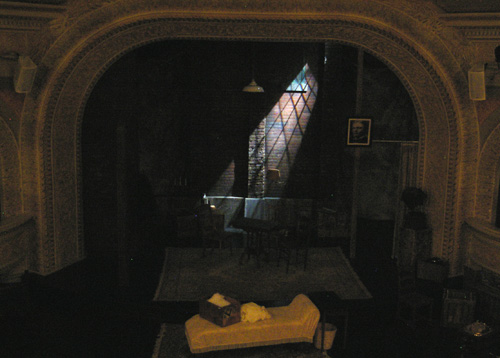
The window on stage.
As happens with many early ideas, this warehouse idea mutated. In the end, the action unfolded in the scripted apartment. The warehouse scenery behind represented a warehouse in Tom's imagination.
Even so, thank goodness that the upstage wall remained. It provided the perfect place to indicate time of day, using the window template and the window built into the scenery, which could also light up. The window template also gave an interesting visual element to the wall, streaking across the brick texture and bringing out its dimension. It gave some grit to the tense and worrisome world with which this family grapples.

Couldn't resist the chance to show off how much the lighting contributes to a production.
Here's the set with "no" light...or rather....worklight. The stage is being set for a run-thru.
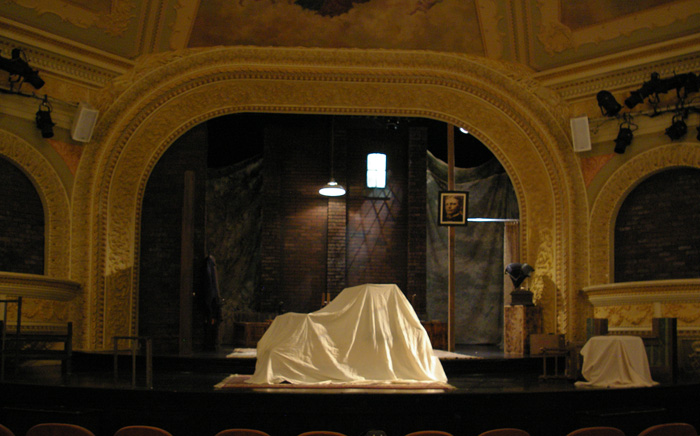
Here's what the audience saw upon entering the theater. The apartment is uninhabited and the furniture piled under covers.
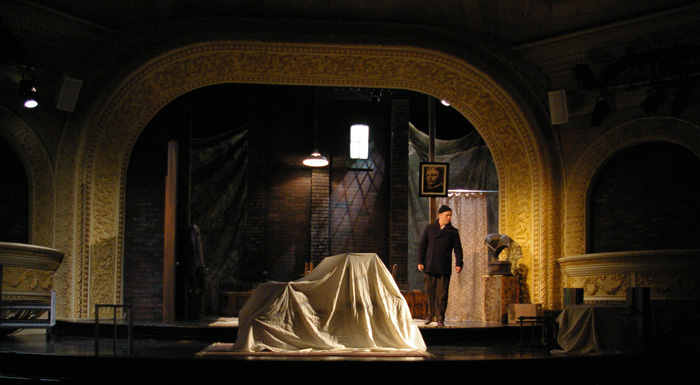
Performance opening. Tom arrives in the abandoned apartment, with imaginings of a warehouse serving as backdrop.
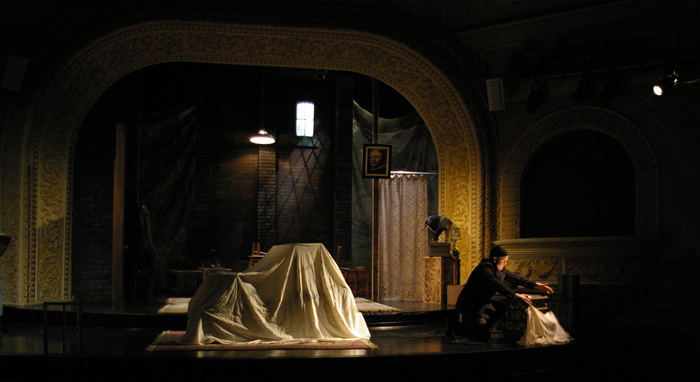
Tom uncovers the glass menagerie
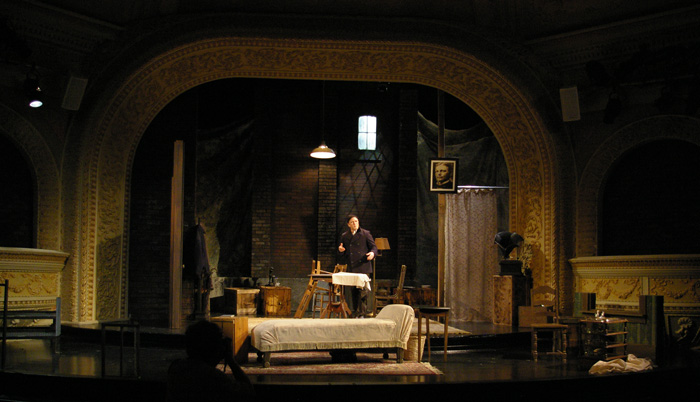
Tom has uncovered the furniture and is about to unfold the tablecloth
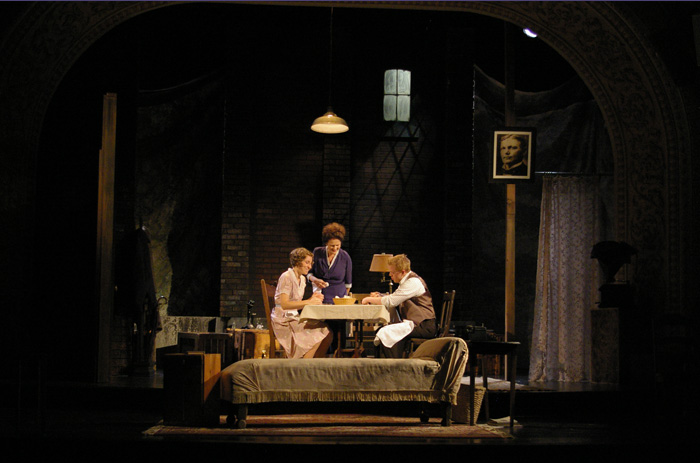
The opening dinner scene
The Candle Conundrum
Naturally, a major issue was how to light the scene between Jim and Laura with the scripted candelabra as the only light source.
Plan A:
The ideal...real candles and live flame. We planned all the standard safety precautions for open flame on stage (fire extinguisher in hand in the wings, stage management monitoring the flames.) We had support from the director, the artistic director and even the fire marshall. Despite this, we were unable to secure permission from our performance venue. We were disappointed. But necessity is the mother of invention.
Plan B:
Battery operated candelabra. This would seem like an obvious choice. But our limited resources would not allow a purchase. An expertly constructed candelabra that had served us well in a prior season had vanished from stock. Making a new one would have required significant work from our already overwhelmed props person. Battery operated candles emit an anemic amount of light. (Real candles, by contrast, are bright enough to actually use as a light source in these circumstances.) We decided against the battery operated candles.
I began rethinking a drawing I had made to study a single source such as a candle.
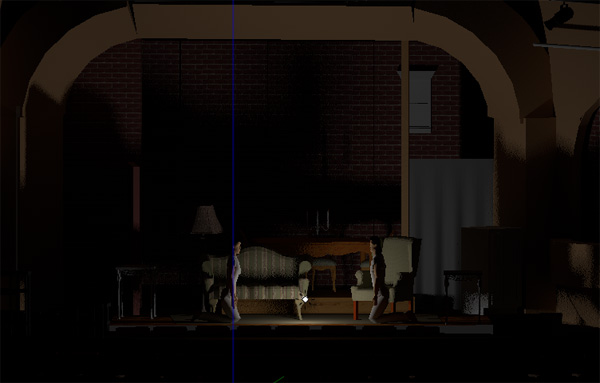
The small white dot near the floor between the two human figures represents the candelabra. Though this drawing is dark overall with the brightest light near the performers, there is another aspect that I began to contemplate. The light goes everywhere. Once your eyes adjust to the dimness, you can see the entire room by the candlelight.
Plan C:
An idea began to take root in my mind. What if we used real candles with real wicks, but did not actually light them? Instead, we would do a visible light cue to mimic each flame lighting up. By using the stage lights to create the candle light, I could make a more easily controlled puddle of light and contain the spill to the area around the actors rather than having it go all over. In the end, we did this option. It worked exceedingly well. The actor mimed lighting each of the 3 candles using a match with no flame. As he "lit" each candle, an obvious light cue added more light. As the candelabra was subsequently moved, we did cues to make a puddle of light move with it.

Light around the table once all 3 candles were lit. The surround drops into darkness.
OK, I cheated a tad of light onto Laura examining her menagerie down left. (This image and the ones that follow may be best viewed in a darkened enviromnent.)
The Laura and Jim scene ended up looking spectacular. It gave them the privacy they needed for their intimate conversation. When Amanda interrupted them with her lemonade tray, she emerged from the shadows and came into the light.
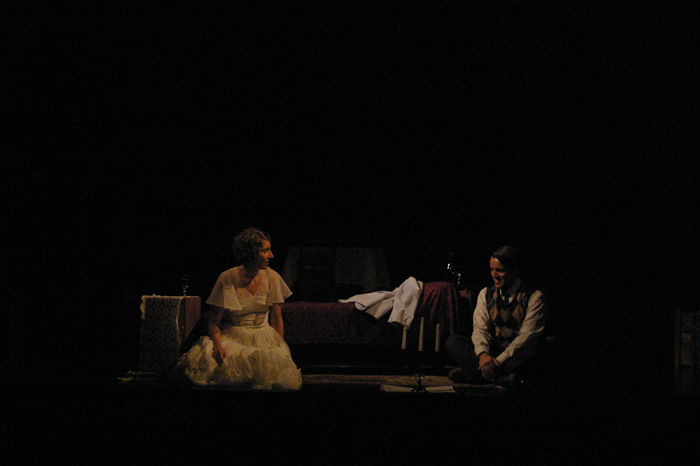
Laura and Jim in the privacy of the puddle of light from the candelabra.
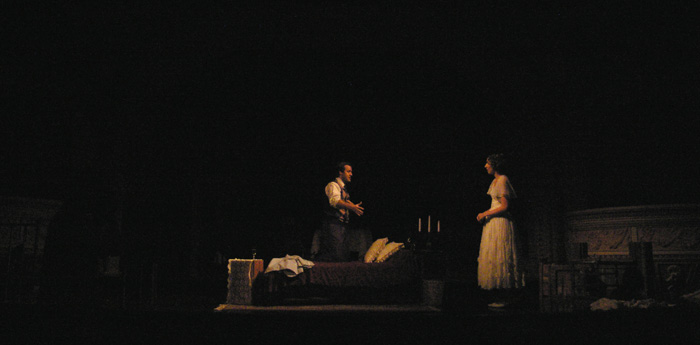
Now they've moved the candelabra to the table. But it is still the main light source for their conversation.
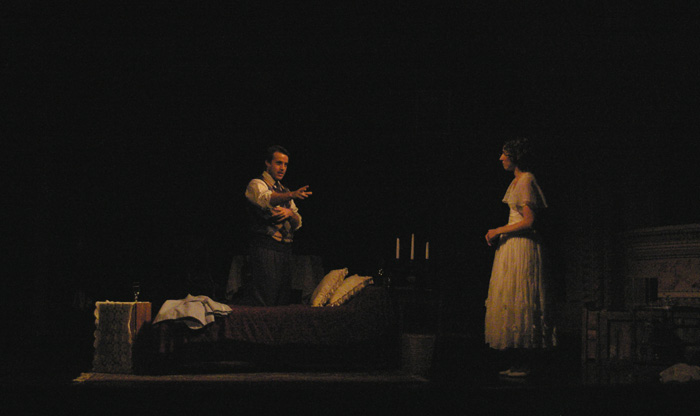
A closer view of the same scene
This show was one of the most beautiful that I've done. It was a lighting designer's dream to sit in a performance and watch these scenes unfold. It was also a captivating experience to be in the theater to hear the audience murmur as the candelabra was "lit" and the audience realized the convention we were establishing. Photos cannot capture that movement. It's a testament to the nature of live theater. The moment happens in the theater and then it's gone.
Please see the GLASS MENAGERIE gallery page for more photos of this show.
Return to Process Homepage
